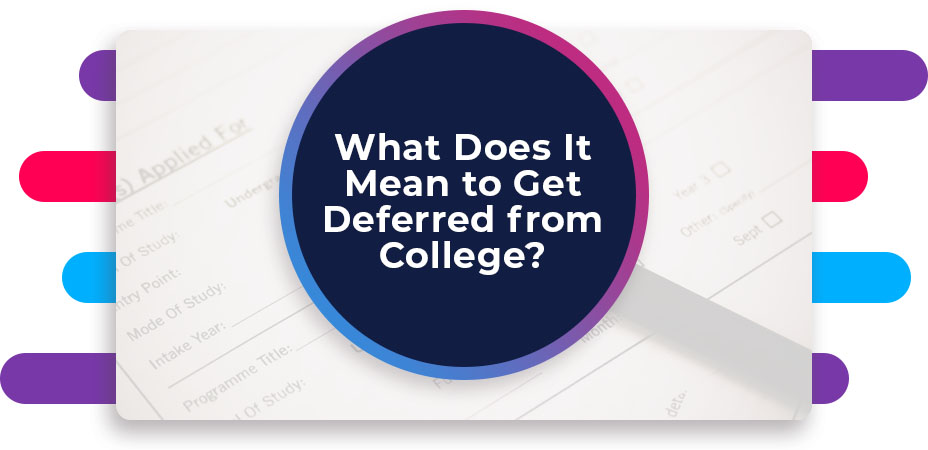In many ways, applying to grad school isn’t that much different from applying to college as an undergrad. The application playbook goes like this: You research schools and programs, take the necessary tests (shoutout to the GRE!), submit transcripts, apply for college scholarships (because nobody wants to spend 2+ years stressing about finances on top of thesis work), and get impressive letters of recommendation to bring it all home.
FIND COLLEGE SCHOLARSHIP OPPORTUNITIES
But there’s another critical part to your grad school application, and it’s one that seems to stress out every grad school hopeful. We are, of course, referring to the personal statement.
If you’re mega confused on how to write a personal statement for grad school, don’t worry — you’ve come to the right place. Below, we’ll answer all your questions about the often misunderstood personal statement, including what it is and how to write a personal statement for grad school that makes your application stand out. Graduate degree, here you come!
Related: What Is a Graduate Degree?
So, What Is a Personal Statement for Grad School?
Remember the good ol’ days of filling out Common Application Essays for your college applications? You were given a simple essay prompt such as “tell us your story,” and away you’d go, explaining how an Uber driver helped you pick the right career or how a K-pop band changed your life.
A personal statement for grad school is somewhat similar to undergrad essays, only a little more serious and career-focused. Basically, it’s your opportunity to show the graduate committee who you are and why you’re a good fit for the program. If you have a unique or compelling backstory to your career path or field of study, your personal statement is your chance to tell it.

How Important Is the Personal Statement?
Do not underestimate the power of a personal statement for grad school applications. Grad school admissions committees use the personal statement as a tool to assess your knowledge, experience, motivations, and readiness to pursue graduate study.
Grad schools are looking for the best and the brightest students who will make a positive contribution to their program or department. If your GPA and GRE test scores aren’t particularly wow-worthy, your personal statement could be the thing that tips the decision in your favor.
Related: What Do Colleges Look for?
Similarly, a damaging personal statement could tank your chances of getting into grad school. In fact, some researchers refer to it as one of the five “Kisses of Death” in grad school applications.
Personal Statement vs. Statement of Purpose – What’s the Diff?
While researching how to write a personal statement for grad school, you may have stumbled across something called a statement of purpose, or SOP. At a glance, a SOP seems awfully similar to a personal statement. Is there a real difference between the two?
The answer is: maybe. It sometimes depends on the department and program. For example, personal statements and SOPs are often used interchangeably in STEM graduate programs.

But in general, there is a slight difference between a statement of purpose and a personal statement. A statement of purpose is typically a two-page essay that discusses your motivations for pursuing your field of study and why you chose to apply for that particular program.
A personal statement is, well, more personal. It’s a crisp, one-pager that provides insight to you as a person. Put simply, it’s your opportunity to tell your story and expand upon what you’ll bring to the program.
Sometimes, the subject matter of SOPs and personal statements can overlap, which only adds to the confusion. But if your grad school application specifically asks for a personal statement, don’t stress! In the next section, we’ll talk about what should go into a personal statement (and what shouldn’t!).
What Goes into a Personal Statement for Grad School?
Typically, graduate schools will give you an essay prompt or questions to answer. For example, you may be asked to describe a challenging time in your life and how you overcame it. Perhaps you might talk about what sparked your interest in your chosen field in the first place. No matter what kind of prompt or questions you’re given, the end goal is the same: to highlight the most interesting aspects of your journey without writing your entire autobiography.

With that in mind, your personal statement will likely include the following:
- Reasons for selecting your chosen career. This is one of the most common essay prompts for grad school applicants. In your essay, you may want to discuss how your personal background or circumstances informed your decision to pursue a graduate degree. Elaborate on your current interests and career goals.
- Experiences that relate to your field of study. The grad school admissions committee will want to be assured that you’re ready to take on the challenges of grad school and, more specifically, the program you’re applying to. Use this opportunity to emphasize career-related experiences, such as internships and volunteer opportunities. What did you learn from these experiences and how have they helped prepare you for graduate studies?
- People who may have influenced your interest in a topic. Yep, you can name drop — in fact, it’s encouraged (assuming it’s relevant, of course). Maybe you’re extremely interested in a faculty member’s area of research and would love to work with them. Perhaps you had a professor who helped you pursue a particular interest in your field.
- An explanation for any gaps in your academic record. Quick disclaimer: Be careful with this one. While it can be beneficial to offer an explanation for low test scores or poor grades, you don’t want it to sound like you’re making excuses for yourself. Describe the problem and the steps you took to turn the situation around.
What Shouldn’t Go into a Personal Statement for Grad School?
We’ve covered what should go into a personal statement. Now, let’s talk about what should NOT go into a personal statement:
- Transcript details. Avoid talking about the details of your transcript, even if you have a high GPA and aced your GRE test. Remember, the entire point of a personal statement is to paint a picture of you that goes beyond test scores and grades. Don’t waste your precious word count talking about things the grad school admissions committee already knows about you.
- References to your mental health. Generally speaking, it’s not a good idea to talk about your mental health struggles in your personal statement. References to your mental health can potentially cast doubt upon your ability to handle the rigors of graduate school. Note that this advice still holds even if you’re applying to a psychology program.
- Inappropriate humor. On a similar note, making an attempt at humor in your personal statement can be hit or miss. (Sure, someone might chuckle at your joke, but what if the person reading your application is an old curmudgeon?) Use at your own risk. If you decide to go for it, be sure to keep it lighthearted and tasteful.
- Generic statements about the field. Avoid saying non-specific things like, “I love all aspects of history.” Grad school isn’t a place to explore broad topics. Graduate committees want to see that you’re passionate about a particular area of research.
How Do I Write a Personal Statement for Grad School?
Getting started is always the most difficult part of writing a personal statement. Where do you even begin?
Follow these tips for creating a strong personal statement that clearly demonstrates what you’ll bring to the graduate school community.
Do Your Homework
The first step to writing a personal statement is to gather information. Start by visiting the website of the school/department/program you’re applying to and highlighting which aspects of the program appeal to you. Identify faculty members in your area of interest and read through their publications. Also, make sure that you’re up to speed in your field. Read articles about the latest developments in your field and the challenges it currently faces.
Reflect and Brainstorm
Now, it’s time for a little introspection. Think about your intellectual development over the years and what led you to pursue your current area of interest. (Tip: Consider taking a nice, long walk to reflect. It seriously helps!)
Here are some questions to ask yourself:
- Why did you choose this particular area of interest/topic?
- Who or what influenced you along the way?
- What are your career goals?
- Where do you see yourself in 10 years?
- What makes you excited about the field?
- What do you hope to accomplish?
Then, compile your answers/thoughts/ideas into a Google Doc. You can refer back to this document when you begin writing your personal statement.
Create an Outline
Next, use your answers and ideas from the previous step to create an outline of your personal statement. Your outline should include a thesis, along with examples to support it. Be sure to list events in chronological order to avoid confusing the reader.

- First Paragraph. Introduce yourself and provide the reader with the big picture. Start your essay with something that will hook the reader.
- Middle Paragraphs. Provide examples and experiences that support the big picture. This is where you’ll connect your past with your future career goals.
- Final Paragraph. End strong by referring back to your intro and restating your thesis. Restate why this graduate program is a good fit for you and what you’ll bring to the community.
Be Authentic (But not too Authentic)
Don’t try to be somebody you’re not in your essay. Instead, let your personality shine through your writing by being honest and authentic. Find your unique angle and highlight the interesting aspects of your journey. Remember, graduate committees want to get a sense of the real you!
On the same token, don’t be too honest in your essay. Nobody wants to read an overly detailed essay about your year-long struggle with hemorrhoids.
Revise, Revise, Revise
Once you finish writing your first draft, read it out loud to yourself. (Spoiler alert: You will probably cringe at what you’ve written. That’s normal.) Go back and make corrections. Sit on it for a few days and make more corrections.
Ask friends and family members with good judgment to look at your first draft. Then, ask a professor or someone in your field to look it over. Take their comments into consideration and revise your personal statement again.

When Should I Start Working on My Personal Statement?
That depends — how stressed out do you want to be while writing your personal statement? If you don’t want to be in a constant state of anxiety, you should start writing at least four months before the deadline (yes, that far in advance!). This will give you plenty of time to do your research, write a first draft, and revise it several times.
Also, don’t wait until the last minute to have a faculty member look over your personal essay. Ask them to look at it at least a month in advance of the application deadline.
Related: When to Apply to Grad School
Final Words
Writing a personal statement for grad school may seem daunting at first, but it gets easier when you break down the process into simple, doable steps. Just remember to give yourself plenty of time to brainstorm ideas and write multiple drafts. Your first few tries will probably be “meh.” But after many revisions, you’ll eventually end up with a strong personal statement that tells a compelling story.
Have you gone through the grad school application process? Share your experience with the Tallo Community! You could help make someone’s application process that much easier.
Image Credits:
Ivan Kruk / Shutterstock.com
Dragon Images / Shutterstock.com
Anton Gvozdikov / Shutterstock.com
fizkes / Shutterstock.com
Tero Vesalainen / Shutterstock.com








